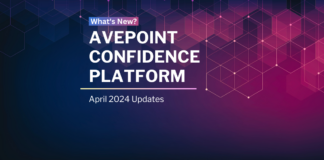Interested in your own digital transformation journey? Check out our latest eBook: Digital Transformation Roadmap.
CEO BLOG: #TechIntensity Explained: 4 Ways It Shifts Business Strategy Forever
There is one constant in the technology world: change. Technology changes, businesses change, and the way in which business is done changes. All of these are facts that today’s organizations must negotiate, and the latter is especially true in tech these days.
Times are changing, and the way technology is sold and marketed is changing with it. The on-prem software world is shrinking as its cloud counterpart only continues to grow.
Anticipating this massive disruptive change of technology and business model, we here at AvePoint decided to fundamentally change the way we do business 4 years ago.
Out with the Old: From Perpetual License to SaaS
Previously, like most of the traditional enterprise software companies, we used to rely on the perpetual model license/maintenance model, meaning that customers buy a license to own an instance of our software in perpetuity, and then pays us yearly maintenance to get the latest version of that software along with technical support on the use of that software.
In making the big jump into the fast-moving Cloud world, where subscription and consumption are the name of the game, we decided four years ago to make the transition, as a business, from our perpetual license model to a subscription-based business model.
In with the new
One major challenge was the ongoing costs associated with a business model of this type.
When you have customers on Software as a Service (SaaS) subscription, we now incur costs to run that SaaS platform — for storage, bandwidth, compute, as well as maintaining a 24×7 Cloud operations team. In addition, we now must maintain a security team to make sure that we do ISO certification and cloud security validation and conduct regular audits. These ongoing efforts increase costs and reduces margins.
 The second part of the learning process was understanding that certain business relationships would change or dissolve altogether.
The second part of the learning process was understanding that certain business relationships would change or dissolve altogether.
Just as the transition to Cloud was a massive undertaking for us, many of our existing partners also faced daunting challenges and existential threats, some of whom, unfortunately, were less successful than others in making the shift.
This means new partnerships and new engagement models, those that are more based on run rate revenue sharing, as well as ongoing customer and partner relationship management which strengthens annual reoccurring revenue (ARR) streams.
What we had going for us, however, were other revenue streams from things like software licenses and services maintenance. This helped ease the transition.
Lessons Learned
It was definitely a learning process. What we had going for us was a very healthy maintenance stream, so that even in the perpetual software license world of the existing customers, they were paying their maintenance contracts.
That formed a really good transactional basis for us. Another great vector for us was that the velocity of our cloud customers is very high, and we’re picking up a lot of customers on the cloud side. Thus, while the upfront cash received was less, the velocity in our new cloud business helped us in conjunction with strong financial discipline.
That learning process meant realizing that such a change was a fundamental shift in the way that we do business. The change speaks to a larger evolution of the industry.
“Overall, it’s an evolution of the software industry. If you look at all the public software companies, the majority of them are going through that. Once you’re in a subscription world, you have a much more predictable revenue stream. Provided that you have very strong customer success organization to ensure continuation and growth of your subscription contracts, it’s much easier to scale and grow the business. In year two and three of the subscription model, you get a better outcome and revenue predictability is a big part of it.”
In addition to the predictability of revenue, another benefit came from the messaging side of things. Now that we have made the change, customers who are considering changes of a similar magnitude can trust folks that have been there and done that.
Been There, Done That
We have gone through it ourselves and we understand what they’re going through. AvePoint embodies a lot of our customers. We are a global company, we’ve truly digitally transformed ourselves. By moving to the cloud we saved $400,000 a year alone just on conference call charges. This is just one of many examples of cost savings and business model upgrades through digital transformation.
It’s an extension of the client relationship dynamic that companies already work so hard to optimize.
We are eating our own dog food. We’re using the latest and greatest in the cloud and that resonates with our customers. Not all our customers are born in the cloud. Ninety-nine percent of enterprise customers come from an on-prem world into a cloud world. They’re going through that journey and they appreciate what we’ve gone through. That becomes part of our value propositions. We understand our customers’ pain much more because we went through it ourselves.
Been there, done that. This is at the core of AvePoint’s transformation. Testimonials and case studies go a long way to communicate expertise to customers, but being able to tell them that we know where you’re coming from and where you want to get to is a gamechanger.
As technology continues to evolve, so will AvePoint. This is how we can continue to be on the cutting edge, providing unparalleled service to our customers.
Looking to make the jump from on-prem to the cloud? Check out some of our migration solutions today!






